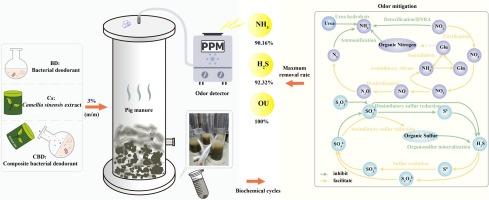山茶花复合细菌除臭剂对猪粪的原位除臭效果及机理研究
IF 7.1
2区 环境科学与生态学
Q1 ENGINEERING, ENVIRONMENTAL
引用次数: 0
摘要
在此,我们构建了一种新型的细菌除臭剂(BD),该细菌除臭剂由鹤化Delftia、反硝化副球菌、酸碱性Pediococcus和velezensis芽孢杆菌组成。在为期5天的猪粪发酵过程中,单用双酚a对NH3去除率为64.84%,H2S去除率为100%,综合恶臭(OU)去除率为63.68%。在复合细菌除臭剂(CBD)中引入山茶花,对NH3和OU的去除率分别达到88.68%和88.14%。在长时间试验中,CBD组NH3、H2S和OU RE的最大RE分别达到90.16%、92.32%和100%。粪便细菌组成显示,施用CBD后,产生气味的微生物(Kurthia、Solibacillus、Proteiniphilum和Acholeplasma)和潜在病原体的丰度下降。功能预测和相关分析表明,这有利于硝化、反硝化和S/N同化过程,而S/N矿化和产甲烷过程可能受到抑制。该除臭剂促进了有臭物质向无臭形式的转化,在养猪场建立了有效的除臭系统。因此,细菌除臭剂与中华梭菌复合已被证明是一种有效的猪场除臭方法。这种方法将推动畜牧业走向更绿色的做法和环境保护,为可持续农业生态系统的发展作出积极贡献。本文章由计算机程序翻译,如有差异,请以英文原文为准。

Efficacy of composite bacterial deodorant constructed with Camellia sinensis and its in-situ deodorization mechanism on pig manure
Here, we constructed a novel bacterial deodorant (BD) composed of Delftia tsuruhatensis, Paracoccus denitrificans, Pediococcus acidilactici, and Bacillus velezensis. The BD alone removed 64.84 % of NH3, 100 % of H2S, and 63.68 % of comprehensive odor (OU) during a five-day fermentation of pig manure. The effect was enhanced by introducing Camellia sinensis in the composite bacterial deodorant (CBD) treatment, with the removal efficiency (RE) of NH3 and OU being 88.68 % and 88.14 %, respectively. In prolonged trials, maximum RE of NH3, H2S and OU RE reached 90.16 %, 92.32 % and 100 % in CBD group. Bacterial composition of manure revealed that the abundance of odor-producing microbes (Kurthia, Solibacillus, Proteiniphilum and Acholeplasma) and potential pathogens decreased after CBD application. Functional prediction and correlation analyses indicated that the process of nitrification, denitrification and S/N assimilation were facilitated, while S/N mineralization and methanogenesis processes might be inhibited. This deodorant promoted the conversion of malodorous substances into non-odorous forms, establishing an efficient odor removal system in hoggery. Therefore, the bacterial deodorant compounded with C. sinensis has been shown to be an effective method for deodorizing pig farms. This approach will advance the livestock industry toward greener practices and environmental protection, contributing positively to the development of a sustainable agro-ecosystem.
求助全文
通过发布文献求助,成功后即可免费获取论文全文。
去求助
来源期刊

Waste management
环境科学-工程:环境
CiteScore
15.60
自引率
6.20%
发文量
492
审稿时长
39 days
期刊介绍:
Waste Management is devoted to the presentation and discussion of information on solid wastes,it covers the entire lifecycle of solid. wastes.
Scope:
Addresses solid wastes in both industrialized and economically developing countries
Covers various types of solid wastes, including:
Municipal (e.g., residential, institutional, commercial, light industrial)
Agricultural
Special (e.g., C and D, healthcare, household hazardous wastes, sewage sludge)
 求助内容:
求助内容: 应助结果提醒方式:
应助结果提醒方式:


